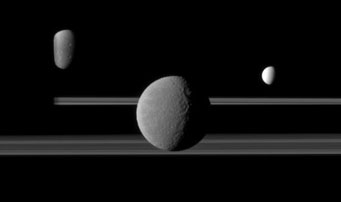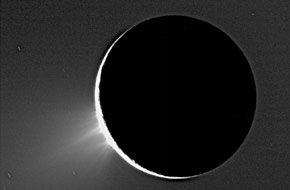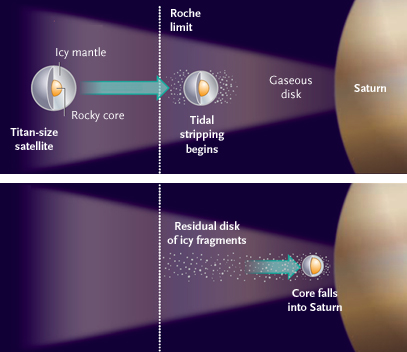A detailed color analysis suggests that the rings of moons of Saturn are ancient creations that in recent times have been coated to varying degrees by a dark, reddish patina.
Is it possible to gauge the age of Saturn's rings and major moons just by measuring how bright they look at different wavelengths? Apparently so, say a team of planetary scientists led by Gianrico Filacchione (National Institute for Astrophysics, Rome, Italy).

On April 25, 2011, the Cassini spacecraft's telephoto camera captured this interplay of three moons with Saturn's rings. Rhea is at center, with Enceladus to its right. Dione is at left, partly obscured by the planet's dark limb. Click here for a larger view.
NASA / JPL / Space Science Inst.
The researchers pulled together more than 2,200 observations of Saturn's moons and several mosaics of its rings taken by NASA's Cassini orbiter from 2004 to mid-2010. These span the spectrum from near-ultraviolet (0.35 micron) to infrared (5.1 microns) wavelengths — a range that includes a pronounced absorption by water ice at 2.0 microns.
It's been long realized that Saturn's immediate family consists almost entirely of water ice. But some parts have been darkened to varying degrees by two unknown dark materials, one neutral in color and another having a reddish tinge. The new work by Filacchione's team suggest that the distinctions in coloration form a pattern of sorts.
For example, the two small moonlets that circle just inside and outside the narrow F ring have different hues. Prometheus, the inner one, is distinctly redder than Pandora and looks to be a close color match to particles in Saturn's densely packed A and B rings. The inner C ring and Cassini Division are redder still.

Finally astronomers have the photographic proof they've been looking for — ice volcanoes actively erupting on Enceladus. In November 2005 the Cassini spacecraft looked back toward Saturn's icy moon and caught its profile backlit by sunlight. In those images, several discrete plumes tower above the 500-km-wide satellite. The spray fills Saturn's E ring with icy particles that ultimately coat many of the planet's other satellites. Click on the image for a larger version.
Meanwhile, the moons appear progressively less contaminated moving from tiny Janus and Epimetheus outward to Enceladus, which doesn't look tainted at all. The authors attribute this to the fact that geysers near the south pole of Enceladus are constantly spouting off, creating a tenuous fog of frozen ice particles that continually coats neighboring satellites with a thin veneer of fresh frost. Then the reddening trend increases among the moons farther out, from Tethys to Dione to Rhea. Outliers Hyperion, Iapetus and Phoebe continue the trend toward darker, redder surfaces. (Titan wasn't considered, due to its dense atmosphere.)
As the researchers note in March 11th's Astrophysical Journal (you can download their article here), it's not clear what the contaminant is. Some researchers have speculated that it's a thin veneer of dark, neutral-hued dust from infalling meteorites combined with a reddish substance that could be anything from radiation-induced organic goo to iron oxide.
But the spectral signature of water ice is both clear and ubiquitous across the system, leading Filacchione and his colleagues to conclude that its presence in the rings and moons represents the "original chemistry of the circum-planetary nebula from which they condensed." Or, as a NASA press release touts, "Saturn's moons and rings are gently worn vintage goods from around the time of our solar system's birth."
Well, hold on there, NASA. As detailed in my feature article about the planet's magnificent bands in the May issue of Sky & Telescope, two aspects of the Saturnian system put serious constraints on any would-be explanation for how and when the rings and moons formed.
First, as noted earlier, the ring particles (in the main rings, at least) consist almost entirely of water ice. But it's hard to imagine forming them with a pure-ice composition. In most scenarios, Saturn's primordial surroundings should have contained roughly equal amounts of ice and rock. In addition, over time the rings should have become increasingly contaminated with rock, metal, and carbon from meteoroid strikes. Calculations suggest the accumulated debris should account for roughly 10% of the rings' mass, if they're as old as Saturn itself (4½ billion years). But observations suggest that it's no more than about 1%, which, according to ring specialist Jeffrey Cuzzi (NASA Ames Research Center) argues for rings that are no older than about 500 million years.
Second, the rings' origin must somehow be tied to that of Saturn's moons. It's hard to imagine that giant Titan and sizable Iapetus formed so far away from Saturn, or that the mid-size moons near the rings could have ended up with such a wide range of densities. Tethys, averaging 0.98 g/cm3, must be nearly pure ice, whereas Enceladus and Dione — the two moons that bracket Tethys, come in at 1.61 and 1.48 g/cm3, respectively, and therefore must contain lots of rock.

Robin Canup's model for forming Saturn's rings. A massive satellite, differentiated into a rocky core and icy mantle, is forced inward by gas drag. Once inside the Roche limit, tidal forces disrupt the mantle (much of which remains in orbit) but not the core (which falls into Saturn).
Nature
In the past few years theorists have come up with several creative schemes to make ice-dominated rings and moons. You'll have to read the May issue to get the details, but they're all messy scenarios involving lots of cosmic carnage. And calculations by Valéry Lainey (IMCCE, Paris) and others suggest that the Cassini Division might have opened up less than 10 million years ago — in which case, how did its particles become dark so fast?
One critical, but missing detail in all of these models is just exactly how much mass is stashed in Saturn's rings and, specifically, in the dense, optically opaque B ring. The more massive the rings, the less rapidly they'll be tinted by infalling meteoritic debris. Right now there's no way to know the mass for sure — it might be 1020 tons (a couple of Mimas's worth), but the true total might be several times greater.
A little more clarity could come a few years from now. NASA managers have given a green light to keep Cassini going until the planet reaches its northern summer solstice in May 2017. In the final 10 months of operation, mission controllers hope to redirect the spacecraft so it repeatedly dives through the clearing between the innermost D ring and Saturn's upper atmosphere — a gap only 2,000 miles (3,000 km) wide. Careful tracking of the barnstorming spacecraft will not only reveal unprecedented details about Saturn's gravity field (and, from that, its internal structure), but also determine the rings' mass.
By the way, now's a great time to do a little inspection of the rings and moons yourself. Saturn comes to opposition in late April, so the Ringed Wonder has again positioned itself for easy viewing. But before setting up your telescope, be sure to download S&T's new Saturn app for iPhones and iPads.
 2
2
Comments
Phil NIcholson
March 29, 2013 at 2:17 pm
While Kelly's summary of the issues around the origin and age of Saturn's rings is excellent, I would like to correct one minor misstatement concerning the work of Filacchione et al. in the Ap J. The "redness" of the rings and satellites is clearest at the shortest wavelengths (in the blue and ultraviolet part of the spectrum), as measured by the "0.35 - 0.,55 micron slope" in Fig. 1 of the paper. It is not true that the C ring and Cassini Division are "even redder" than the A and B rings; they are in fact much 'less red', as may be seen in the upper panel in Figure 1. This variation in color is strongly correlated with the depth of the 2-micron water ice band (in the lower panel of the same figure), as first pointed out by Nicholson et al. in Icarus in 2008. It is thus suspected, as stated by Filacchione et al, that the unknown reddening agent takes the form of primordial inclusions within the water ice grains on the ring particle surfaces, rather than being some external contaminant added at a later date by meteoritic or cometary impacts.
You must be logged in to post a comment.
Jim Franklin
March 30, 2013 at 4:01 am
Perhaps the creation of the rings was caused by the destruction on one or more icy bodies if Titan was actually captured at a later date than the formation of the Planet as a whole.
The bodies may have already have been in orbit about Saturn but tidal interactions with Titan changed their orbits and two or more catastrophically collided with parts being ripped even more by Saturn's Roche limit.
The coloration could be microscopic dust left over that permeates the system and is slowly swept up by larger bodies in the system, given time this dust would be removed and nor more reddening would occur unless more dust was created by interactions within the system.
You must be logged in to post a comment.
You must be logged in to post a comment.